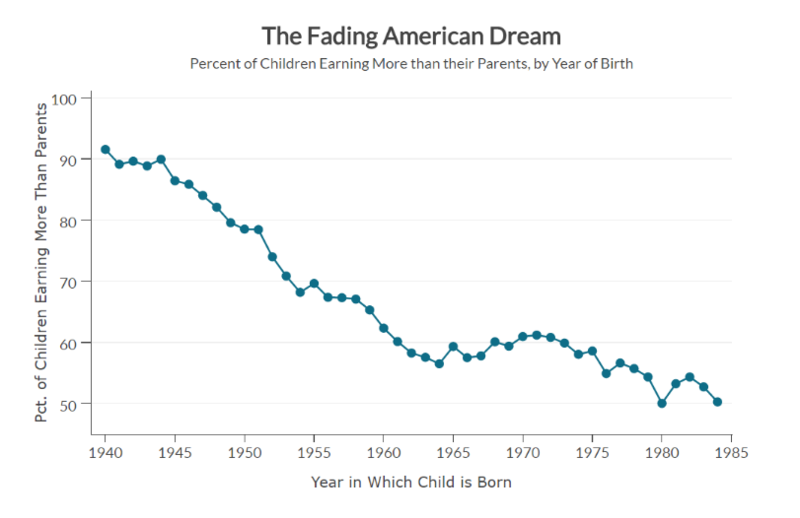Fifty-one percent of the 18- to 29-year-olds who took part in a national poll released by Harvard’s Institute of Politics in late 2016 said they were “fearful” about the future of America. Those fears centered on the attainability of the American Dream, with every demographic within the 2,150 people polling as more fearful than hopeful. The groups with the most widespread anxiety about the future were white women, at 60 percent, and white men, at 54 percent. Only 32 percent of white females think they will do better than their parents financially; just 36 percent of white men think they will.
That pessimism—or realism—extends to expectations for getting Social Security when they need it. Eighty-one percent of millennials worry that Social Security won't be there for them when they want to retire, according to a 2016 survey by the Transamerica Center for Retirement Studies. While a lot of data show that millennials are good savers, there’s only so much one can save if economic opportunity and income mobility are limited.
A sturdier, more comprehensive safety net wouldn't ensure the American Dream, but it would reduce the retirement dread.
This article was provided by Bloomberg News.
All this is shrinking the definition of the American dream. Millennials, in particular, seem disillusioned. Over 50 years, “children’s prospects of earning more than their parents have fallen from 90 percent to 50 percent,” according to the home page of the Equality of Opportunity Project, a research effort that analyzes income mobility. The project is citing figures from a 2016 study (PDF), "The Fading American Dream: Trends in Absolute Income Mobility Since 1940."
These Three Trends Are Eating Up The American Retirement Dream
July 18, 2017
« Previous Article
| Next Article »
Login in order to post a comment
Comments
-
Lots of errors, propaganda and misinformation in this article: 1) A big driver of "income inequality" and the reason the bottom 50% are stuck at $16,200 is that these people are incentivized not to earn more money. A majority of these people are on government benefits - food stamps, aid to dependent children, etc. where they start losing benefits if their income increases. So we've (and by we, I mean the Democrat party), created a welfare trap, keeping them stuck at a very low income, and dependent on the government (so they'll continue to vote Democrat). 2) Social Security is a disaster precisely because it was Socialism from the start, and Socialism always fails. There's never enough money when you punish success (those evil 1 percenters), and push society down to the lowest common denominator. Social Security was never meant to be a retirement program. It was designed (originally) as a safety net for the very small percentage of widows and orphans who survived their breadwinner spouses. But (by design), it has been slowly changed and represented as the only real reliable source of retirement income for most Americans. Finally, Social Security is a disaster, because Congress doesn't care if it fails. In fact they're happy that it's failing, because they can use it as a political hammer to bludgeon their political opponents. If Congress, and the entire DC bureaucracy had Social Security as their "retirement plan" instead of their own, special, gold-plated retirement pension, they'd be motivated to fix it. This is something we hope to change with the Article 5, Convention of States. To force Congress and DC to have the same benefits as the rest of America, the citizens they're supposed to represent. 3) Health care is a disaster because of government meddling, and Obamacare is just the latest in a long line of "wrenches in the works" to our health care system. And before I continue, let's be clear, we're talking about health INSURANCE, not health care. We're forced to buy health INSURANCE, but whether or not we get the care we need is debatable. Health insurance today under Obamacare is just like cable TV. We must pay for 250 channels, when we only want 3 or 4, and to get the additional channel we want, we must pay for 200 more channels we don't want. Health insurance is even worse, because we must buy it. At least we can cut the cord and not pay for any cable TV if we choose. But just like cable TV, the "essential health benefits" say that everyone must by maternity care ... whether or not you're female, whether or not you're 20 or 30 or 80 years old. This is absurd, and is one of many reasons that health INSURANCE costs are through the roof, and why health CARE costs have spiked. I challenge you to watch this video: https://www.prageru.com/courses/economics/government-cant-fix-healthcare and tell me why we shouldn't repeal Obamacare and NOT REPLACE IT, but let the free market work for health care, just like it does for iPhones, Uber, airBnB,etc., etc. In conclusion, the American retirement dream is a mess because our massively bloated, wasteful, fraud-ridden government has meddled with too many parts of our economy to allow people to prosper on their own. By the way, klgmac's comments are true as well - we're meddling with the energy industry through the fraud of "saving the planet".
-
It's too bad we are directing so much of our resources into pretending that we know how to control the temperature's of the planet. Expensive electricity generated by alternative sources is already forcing some people into energy poverty. It's truly a crime against humanity.








